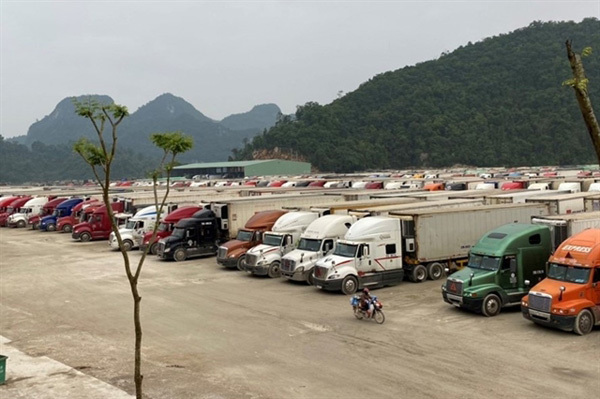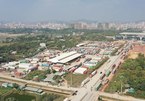 |
| Trucks carrying Vietnamese goods lay stranded at the border due to China's strict COVID-19 preventive measures and sluggish customs clearance. — Photo laodong.vn |
According to the General Department of Customs, the country's agricultural exports by road to China reached up to US$1.58 billion in the first eight-months of 2021. The ongoing congestion has caused losses of nearly VND2 trillion ($87.5 million) to export firms so far.
Some firms have had to turn to air freight to maintain trade flow but it is not cost-effective, costing up to 76 per cent more than road haulage.
The Ministry of Industry and Trade (MOIT) thus urges firms to consider switching from road to maritime transportation and redirect trade routes to other provinces to relieve ongoing congestion.
“We will opt for maritime transportation in the near future because road transportation is too risky. Road congestion every couple of years has really put us off,” said Tran Ngoc Hiep, director of Thanh Long Hoang Hau Ltd.
Nguyen Thi Diem Hang, vice chairman of VinaNutri Food, noted gridlock at Lang Son as a sign that firms were relying too much on unofficial channels. Trade via these channels might incur lower costs but carry higher risks as unofficial exports could face suspension anytime China tightens their regulations.
Therefore, firms are recommended to do business with China more formally to avoid any risk from informal business practices. For instance, trade with Chinese partners should be bound by written contracts with a clear clause of delivery and be conducted via official channels.
“To sustain exports to China, firms need to scrap unofficial trade practices and shift their focus from quantity to quality and value,” Hang added.
MOIT also urges local authorities to keep a close watch on trade activities at border gates and post the latest news on provincial web portals to keep firms well-informed about any changes.
Another solution is to extend the domestic market and diversify foreign markets through trade promotion, supply-demand connection and application of e-commerce in agricultural trade to reduce the dependence on the Chinese market.
In fact, many firms have begun to find customers elsewhere since China raised the bar on fruits and vegetables exported to the country in 2019.
However, China still remained Vietnam’s second-largest export market for agricultural-forestry-fishery products in 2021, with an export revenue of $8.4 billion in the first eleven months.
Bilateral negotiations to increase the working time and efficiency of customs officers at border gates have also been discussed to avert any future congestion. Currently, a number of border gates are processing customs procedures at a rate much below normal.
By December 27, more than 4,000 vehicles, mostly loaded with perishable agricultural produce, are still stuck in Lang Son. Regardless, only Huu Nghi and Chi Ma border gates are processing customs clearance with a sluggish average rate of eight vehicles per hour.
As Tan Thanh continues to be temporarily closed, truck drivers stranded at this border gate would need food and shelter to live for many days to come. In order to help these drivers out, Lang Son authorities have granted them financial support to cover part of their parking and living costs.
Meanwhile, the Private Sector Development Committee (Committee IV) has come up with different solutions to the problem.
For trucks lying stranded at border gates, notably those loaded with agri-fishery exports and raw materials, Committee IV proposes higher-level meetings between the two countries to look at ways to help the trucks move on.
For agricultural produce ready for delivery prior to the Tet holiday, Committee IV urges the government to work with local authorities to put the transport such produce on hold until the situation at the border gates improves.
Farmers are also called on to delay harvesting and put crops in storage to stem new commodity flows to the border.
Communication channels should be used to better regulate the trade flow at border gates, the committee added.
In the long-term, it is necessary to invest more in logistic infrastructure and improve the capacities of warehouses and car parks in border provinces.
As of January 1, 2022, foreign firms producing food exported to China are required to print codes granted by Chinese customs authorities or Vietnamese authorised agencies on both sides of their product packages.
Any Vietnamese food exporter that has yet to apply for the codes can submit applications to relevant agencies or online.
By December 24, Chinese customs authorities had granted 31,988 codes to foreign export firms, of which 1,045 were Vietnamese.
Source: Vietnam News

5,000 container trucks stuck at border gates amid 50 talks with China
The Ministry of Industry and Trade (MOIT) reported that 1,555 trucks carrying exports to China are stuck in Quang Ninh as of December 25, and 4,204 in Lang Son as of December 25. Some of them have been deadlocked for a month.

Congestion at border gates, seaports stalls transport of farm exports
Farm exports experienced a tough year in 2021 due to continued congestion at border gates. Despite this, agricultural produce still reached export turnover of $47 billion for the year.